
Formerly enslaved people escaping by fording the Rappahannock River, VA, August, 1862 (Courtesy of Library of Congress)
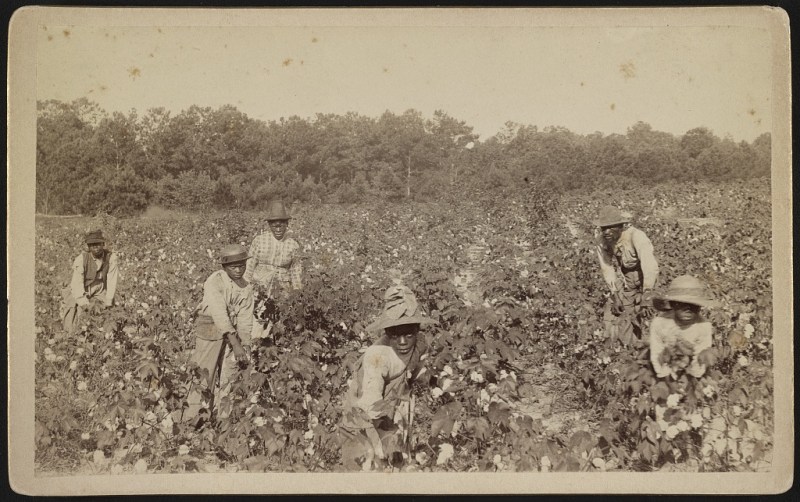
“Let's not forget that Lincoln was a politician, first and foremost, and his goal, especially during the war, was to bring the Confederacy back into the Union fold. And this question of slavery was such a hot button issue, even before his presidency, that Lincoln had a very clear sense of the stakes, of coming out in support of abolishing slavery versus taking a more moderate approach” - Justene Hill Edwards, Assistant Professor and Historian, University of Virginia
Essential Questions:
*What were the events and who were the people that influenced Lincoln’s opposition to slavery?
*Did Lincoln become an abolitionist?
In this lesson, students will conduct independent research and apply skills of historical analysis to trace the evolution of Abraham Lincoln’s position on the abolishment of slavery within the United States. Select film clips from the second episode of Lincoln’s Dilemma, edited interviews created in the production of the film, archival photographs, and historical documents will support student exploration and help them understand how or whether Lincoln’s thinking on abolition evolved.
Students will:
*Trace the historical events that impacted Lincoln’s evolution of thought on the institution of slavery before and throughout the Civil War
*Learn about the individuals who significantly influenced Lincoln’s understanding and empathic response to enslaved people
*Analyze the purpose and limitations of the Emancipation Proclamation
Materials:
*Equipment to screen film clips and Interview Threads
*Copies of Handouts:
-Handout One: Lincoln’s Dilemma Learning Log
-Handout Two: Film Clips Transcript
-Handouts Three, Four, Five, and Six: Interview Threads Transcripts
-Handout Seven: The Emancipation Proclamation
-Handout Eight: “Our Work Is Not Yet Done” by Frederick Douglass
-Handout Nine: Further Suggested Speeches and Documents
Length: Two 55-minute class periods
In pairs, have students interview one another with the following questions:
*When was the last time you changed your mind about an idea or opinion?
*What was it that moved you to change? Was it a personal experience? A friend’s opinion? An article you read?
*Do you think Lincoln’s anti-slavery position changes after he becomes president?
*Drawing on background knowledge, what do you think might need to happen in order to change his thinking?
Teacher Note: The question of Lincoln’s views and stance on slavery, and whether he became fully committed to the cause of abolition, remains a salient and rich historical conversation. Explain to students that for Lesson Two they will be exercising their historical thinking skills to independently explore a range of different historical resources to come to their own conclusions based on evidence. This exercise may take one or two class periods.
Distribute Handout One: Lincoln’s Dilemma Learning Log for students to take notes and synthesize their learning.
The following collection of historical resources is available for student investigation. Students will independently review these resources in order to answer the essential questions of this lesson:
*What were the events and who were the people that influenced Lincoln’s opposition to slavery?
*Did Lincoln become an abolitionist?
Resources
*Watch two film clips from Lincoln’s Dilemma (9 min total)
*View archival photos for visual reference
*Learn from historians in the four Interview Threads (up to 40 min of video but scanning transcripts can shorten this time)
*Analyze historical two documents, along with suggestions for others that may be of interest: The Emancipation Proclamation and Frederick Douglass’ speech “Our Work is Not Done”
Teacher Note: Let students know that the following clips from Lincoln’s Dilemma take place after the 1860 election, when Southern states began to secede from the Union and formed the Confederacy. Students can use Handout Two: Film Clips Transcript to follow along, underlining or highlighting ideas, names, or concepts that stand out as important or that they would like to learn more about.
Watch Film Clip One: “Before the Presidency” (3:58)
In this segment, some Southern states had started to secede from the Union after Lincoln won the 1860 Presidential election. Lincoln is trying to keep the Union together, and has multiple ideas for how to stop the expansion of slavery and/or end slavery, through gradual emancipation and through colonization, sending formerly enslaved people to the newly founded African country of Liberia.
Watch Film Clip Two: “Influenced by Enslaved People” (4:47)
In this clip, Abraham Lincoln thinking starts to shift towards emancipation for multiple reasons, including his own personal experiences meeting formerly enslaved people in “contraband camps,” through meetings with Black and white abolitionists, and because the Union military needed more soldiers.
Teacher Note: Students will use visual analysis of historical photographs to further explore the question of whether and how Lincoln moved from anti-slavery to abolition during his presidency.
Print or project the photos, or make them available in a shared online space, and ask students to answer the following questions:
*Describe what you see in the photo.
*If you could talk to the photographer, what would you want to ask about the photo?
*In what way do you think these photos might be relevant to understanding the context of Abraham Lincoln’s presidency?
Teacher Note: The filmmakers conducted over 25 interviews to produce Lincoln’s Dilemma. The full interviews are available in the Interview Archive. A selection of these interviews, edited together here to create Interview Threads and aligned to the specific lesson topic, are available for your students’ learning.
These interview threads will deepen students’ understanding of Lincoln and his views, and also the specific influences of the other members of his party as well as the broader abolitionist movement. Students can follow along and take notes using the transcripts included in Handouts Three, Four, Five, and Six.
*Lincoln and the Republican Party: Historians Bonner, Ayers, Blumenthal, and Karp discuss Abraham Lincoln’s position and views within the brand new Republican Party.
*Lincoln’s Evolution on Slavery: Historians Berry, Foner, Bonner, Hill Edwards, Burlingame, and Hahn represent different perspectives on Lincoln’s views about slavery from his youth through the Civil War.
*Abolitionist Movement: Historians Bonner, Masur, Medford, and Hahn detail the work and actions of the abolitionist movement, active since the beginning of slavery, during Lincoln’s formative years as a young man and politician and during his Presidency.
*The Importance of Women Abolitionists: Interviewees Berry, Bunch, Cobb, Hill Edwards, and Sinha describe the work of women abolitionists, whose stories have been broadly overlooked.
Teacher Note: Two documents are included: The Emancipation Proclamation and an excerpt from abolitionist Frederick Douglass’ speech “Our Work is Not Yet Done.” A list of other speeches by Lincoln and Douglass are included below.
Handout Seven: The Emancipation Proclamation
The Emancipation Proclamation, issued January 1, 1863, marks a critical juncture in the Civil War. This Presidential Proclamation officially freed the enslaved people in the Southern states, parrishes, and counties that had joined the Confederacy, and it allowed formerly enslaved people to join the Union Army. It did not free enslaved people in the border states.
Handout Eight: “Our Work is Not Yet Done”
In this speech, Frederick Douglass describes meeting President Lincoln to demand equal treatment of Black soldiers in the Union Army.
Students can record and synthesize their learning using Handout One: Lincoln’s Dilemma Learning Log. Let students know they will be referring back to their Learning Log in order to complete their Final Project, proposing a memorial to this era of American history.

Formerly enslaved people escaping by fording the Rappahannock River, VA, August, 1862 (Courtesy of Library of Congress)
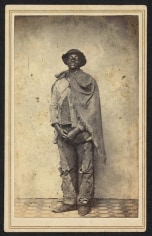
William Headly, escaped enslaved man, Raleigh, NC, ca 1862 (Courtesy of Library of Congress)
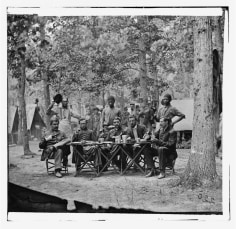
Two young Black men stand behind a group of seated white officers, Camp of the 93rd New York Infantry, Bealton, VA, August, 1863 (Courtesy of Library of Congress)
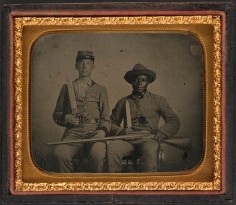
Sergeant A.M. Chandler and Silas Chandler, an enslaved man, ca. 1861 (Courtesy of Library of Congress)
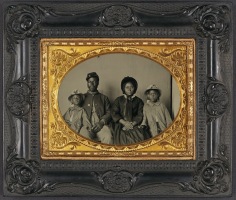
Unidentified African American Union soldier, with his wife and two daughters, ca. May 1863 (Courtesy of Library of Congress)
This lesson supports course work in American Studies, African AmericanHistory, US History (Honors/AP), and Government (Honors/AP). As Common Core remains a state-led effort, consult your state guidelines for the most current framework. Skills and content in each of the four Lincoln's Dilemma lessons fulfill all four Dimensions outlined in the C3 Framework--College, Career, and Civic Life. This resource can be useful in aligning your lessons to standards.
